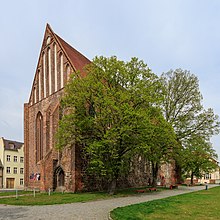Franciscan monastery church Peter and Paul
The former monastery church Peter and Paul of the Franciscan monastery in Angermünde , which was secularized in 1543, is a brick Gothic building that will serve as an event room after its renovation. It is entered as No. 09130263 in the list of monuments in Brandenburg.
History of the church and monastery
The Franciscan Order, founded in 1210, quickly spread to the Baltic Sea in Germany in the 13th century and preferred cities for its settlements. Around 1250 monasteries were founded in Berlin and Szczecin . Around this time the Franciscans also settled in Angermünde, which had received city rights in 1254 . After the color of the - the monastery Order Habits called the Franciscans the "Grawe monastery" - was in 1260 probably from askanischen Margrave Johann I founded. It belonged to the custody of Stettin of the Saxon Franciscan Province ( Saxonia ) and was in the diocese of Brandenburg . It was first mentioned in a document in 1299. This year, as in the 14th century, a provincial chapter of Saxonia met there several times , so that the monastery must have had a certain size.
The church, which was built in the 13th century, was originally a single-nave granite block. From around 1300 it was extended to an elongated brick building with two naves of unequal width by adding a northern extension . The nave and choir are separated by a brick rood screen . The timbers of the roof structure, which was never destroyed, were dendrochronologically dated to around 1440, which suggests that the roof was built at the beginning of the 15th century. The church served as a burial place for several aristocratic families in Brandenburg .
In the dispute over the issue of poverty in the Franciscan Order in the 15th century, the Angermünd Franciscans joined the stricter direction. The Reformation , which from 1539 by Elector Joachim II. Was introduced in Brandenburg, they made a long resistance. In 1556 the Provincial of the Saxon Franciscan Province still had his seat in the monastery in Angermünde. In the same year, the last Franciscans had to leave the monastery, and the elector gave the monastery to Hans Flanß, Captain von Beelitz , who sold it to the city of Angermünde in 1567 for 1000 richstaler.
Church and monastery fell into disrepair. When the Huguenots settled in the Uckermark, the church was restored and from 1699 to 1788 it was partially used as a Reformed Church .
The choir served the military as a magazine as early as 1725. The demolition of the adjoining monastery to the south with two cloisters was ordered in 1767 by the city's magistrate; the stones were used in the construction of a factory at the Schwedter Tor . The church vault was demolished in 1825. In the further course of the 19th century, renewed maintenance work began, initiated by King Friedrich Wilhelm IV. Restoration work also took place during the Nazi era . After German reunification, the monastery church was converted into an event hall.
literature
- Georg Dehio : Handbook of the German art monuments. Brandenburg. Berlin, Munich 2000, ISBN 3422030549 , pp. 22-25.
Web links
Individual evidence
- ↑ Ursula Creutz: History of the former monasteries in the Diocese of Berlin in individual representations. Leipzig 1995, ISBN 3-89543-087-0 , p. 203.
- ↑ Ursula Creutz: History of the former monasteries in the Diocese of Berlin in individual representations. Leipzig 1995, ISBN 3-89543-087-0 , p. 204.
- ↑ Ursula Creutz: History of the former monasteries in the Diocese of Berlin in individual representations. Leipzig 1995, ISBN 3-89543-087-0 , p. 203.
Coordinates: 53 ° 0 ′ 58 ″ N , 14 ° 0 ′ 21 ″ E


